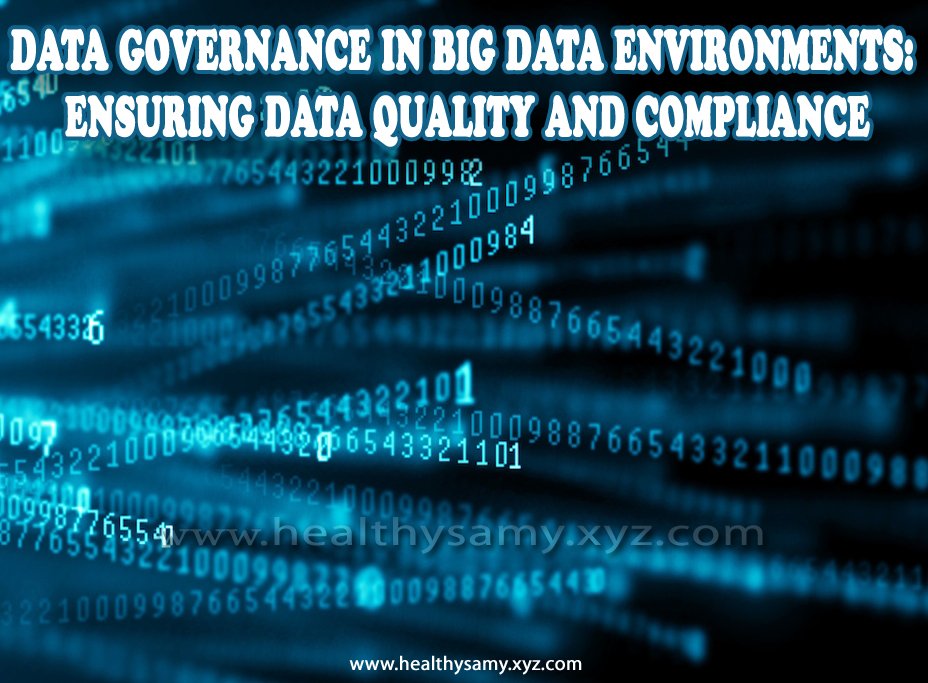In today’s data-driven landscape, where organizations are dealing with vast volumes of data, maintaining data quality and ensuring compliance has become more critical than ever. This is where data governance comes into play. Data governance provides a framework for establishing policies, processes, and controls to ensure the availability, usability, integrity, and security of data. In the context of big data environments, data governance becomes even more crucial. In this article, we will explore the importance of data governance in big data environments and discuss strategies for ensuring data quality and compliance.
The Importance of Data Governance in Big Data
Big data environments present unique challenges due to the sheer volume, velocity, and variety of data. Implementing effective data governance practices is essential for the following reasons:
- Data Quality: Big data environments often consist of diverse data sources, including structured, semi-structured, and unstructured data. Ensuring data quality becomes critical to prevent inaccuracies, inconsistencies, or biases that can impact decision-making processes. Data governance helps establish data quality standards, data cleansing processes, and data validation techniques to maintain the accuracy and reliability of data.
- Data Integration: Big data environments involve integrating data from various sources, such as internal systems, external feeds, or third-party datasets. Data governance ensures proper data integration processes, mapping data attributes, and addressing data compatibility issues. It promotes data consistency and standardization across different datasets, enabling seamless integration and analysis.
- Data Privacy and Security: Big data environments often contain sensitive or personally identifiable information (PII). Data governance provides mechanisms to define and enforce data privacy and security policies, including access controls, encryption, and anonymization techniques. It ensures compliance with data protection regulations, mitigates data breach risks, and safeguards the privacy of individuals.
- Regulatory Compliance: Organizations operating in big data environments need to comply with industry-specific regulations, such as GDPR, HIPAA, or CCPA. Data governance ensures that data management practices align with regulatory requirements. It facilitates data classification, retention policies, audit trails, and data lineage, enabling organizations to demonstrate compliance and avoid legal and financial penalties.
- Data Ethics: With the increased use of advanced analytics and AI algorithms in big data environments, data governance plays a vital role in ensuring ethical data usage. It establishes guidelines for responsible data handling, addressing issues related to bias, fairness, and transparency in algorithmic decision-making. Data governance frameworks encourage ethical practices and help build trust among stakeholders.
Strategies for Ensuring Data Quality and Compliance
To ensure data quality and compliance in big data environments, organizations should consider the following strategies as part of their data governance framework:
- Data Governance Framework: Establish a comprehensive data governance framework that defines roles, responsibilities, and processes related to data management, data quality, and compliance. This framework should align with organizational goals, industry regulations, and best practices.
- Data Cataloging and Metadata Management: Implement data cataloging and metadata management practices to document and track information about data sources, data types, data owners, and data lineage. This helps in understanding the data landscape, ensuring data traceability, and facilitating data discovery for compliance and analysis purposes.
- Data Quality Assessment: Regularly assess and monitor data quality using appropriate tools and techniques. Implement data profiling, data validation, and data cleansing processes to identify and address data quality issues. Establish data quality metrics and perform data quality checks at different stages of the data lifecycle.
- Data Stewardship: Appoint data stewards responsible for data governance activities. Data stewards ensure compliance with data governance policies, monitor data quality, and facilitate data-related decision-making. They act as subject-matter experts and advocates for data quality and compliance within the organization.
- Data Privacy and Security Measures: Implement robust data privacy and security measures. This includes defining access controls, encryption mechanisms, data masking or anonymization techniques, and regular security audits. Ensure that data handling practices comply with relevant data protection regulations and industry standards.
- Data Lifecycle Management: Implement data lifecycle management practices, including data retention policies, archival processes, and data disposal mechanisms. Define rules for data retention and deletion based on regulatory requirements and business needs. Properly manage data backups and disaster recovery procedures to ensure data availability and resilience.
- Data Governance Training and Awareness: Provide data governance training and awareness programs for employees to educate them about the importance of data quality, privacy, and compliance. Promote a data-driven culture that values data governance and encourages responsible data handling practices.
Conclusion
Data governance is a critical component of managing big data environments. It ensures data quality, promotes compliance with regulations, and establishes a foundation of trust and reliability in data-driven decision-making processes. By implementing effective data governance practices, organizations can maintain the integrity, availability, and security of data in their big data environments. They can derive meaningful insights, drive innovation, and meet the evolving demands of data privacy and compliance in today’s dynamic business landscape.a










